Getting the right protein and nutritional requirements for a pit bull puppy diet can get a little complicated.
While the factors that go into choosing a quality commercial dog food for your pit bull also apply to puppy foods, your pit bull puppy has special nutritional requirements that make many otherwise high quality foods inappropriate, even dangerous, during the growth stage.
But don’t worry. We will break it all down for you, so you’ll know exactly how to feed your new pit bull family member and what to look for in a puppy food.
5 Best Food For Puppy Pit Bull
The Farmer’s Dog – Best Food For Pit Bull Puppy Diet
The Farmer’s Dog Beef Recipe is our top pick for puppy food for pit bulls. This meal includes USDA beef, USDA beef liver, lentils, sweet potatoes, sunflower oil, kale, carrots, fish oil, and a customized vitamin cocktail created by The Farmer’s Dog.
Pepe’s Beef also has all of the vitamins and nutrients that growing pit bull puppies require in order to be healthy and strong. You’ll notice that Pepe’s Beef meets the AAFCO Dog Food Nutrient Profiles for All Life Stages’ nutritional needs and values.
Larger dog breeds, such as pit bulls, are covered by these AAFC
The only problem with The Farmer’s Dog Beef Recipe is that you have to freeze it and then thaw it in the fridge a day before you want to cook it. This usually isn’t a problem, but if you’re busy and forget, your dog may have to eat something else that day.
Overall, we believe that The Farmer’s Dog is the best food for Pit Bull puppies available today.
Rachael Ray Nutrish Bright Puppy – Best Value
Your Pit Bull puppy will be unable to resist this high-quality puppy food, which is made with American-grown, pasture-raised chicken that is slow-roasted to retain all of the tastes and juices.
Rachael Ray Nutrish dry puppy food contains a variety of fresh fruits and vegetables that help promote your dog’s health as they mature.
This mix is a good diet for Pit Bull puppies. It contains cranberries which give the puppies vitamin C. This helps them to absorb all the other nutrients in the food.
One last thing, because this dinner has a significant amount of rice, you should not offer your Pit Bull puppy a grain-free diet if that’s what you want to do. Other than that, this option could be great for your pit.
Taste Of The Wild High Prairie Puppy Food
Taste of the Wild High Prairie puppy food is designed to provide your dog with a natural, balanced diet. This dog food substitutes beef and chicken for fresh buffalo and bison to satisfy your pup’s natural cravings.
This diet is high-quality and grain-free. It has vegetables like chicory root to promote a healthy digestive system and give necessary nutrients for strong bones.
However, you could expect to pay more for this puppy food than the previous two choices on the list.
If your puppy is used to eating chicken and beef, they may not like the taste of bison and buffalo.
Hill’s Science Diet Puppy Dog Canned Food
This wet dog food was developed to improve puppy health and immunity, which is critical for pups that want to go outside and encounter viruses and other dangers.
If your Pit Bull puppy has trouble digesting dry food, they may have more success with this alternative from Hill’s Science Diet, which is formulated to promote easy digestion. Puppies typically prefer wet food since it is simpler to chew and consume.
However, It’s possible that you’ll have to brush your dog’s teeth every now and then throughout the day, as this food will often cling to the teeth.
The disadvantage, on the other hand, is that it is more expensive than dry dog food, so you may find yourself unable to meet your Pit Bull puppy’s nutritional needs as it grows.
Life Protection Blue Buffalo Puppy Food
The primary goal of Blue Buffalo Life Protection puppy formula is to support the growth and development of your Pit Bull puppy. This meal is high in high-quality protein and various vitamins and minerals that your dog will need as they grow their bones and muscles.
Your dog will get a complete diet that is high in real meat and low in carbohydrates, which are good for their heart and keep them healthy. They’ll also eat vegetables to stay healthy, as well as fruits to boost their energy levels while playing or growing.
Your Pit Bull needs supplements to help keep their bones healthy. The calcium and phosphorus will help, especially as they gain more weight. DHA and AHA will help with the eyes and brain.
They also need essential fatty acids to help them stay full between meals and have healthy coats.
Keep in mind that many puppies get diarrhea when changing to this diet. This undesirable side effect, on the other hand, is only temporary.
So even though there are some drawbacks, such as other foods, it’s still a good choice when considering giving your puppy high-quality proteins, vitamins, and minerals.

Get the 7 Biggest Training Mistakes free report!
Large Breed Puppies & Skeletal Disease
Puppies require higher levels of certain nutrients for healthy growth, but excessive levels of some of these very same nutrients have been implicated in skeletal disease in large breed puppies.
Matters are further complicated by the fact that there are many misconceptions about the link between nutrition and bone health, and a fine line between what’s necessary to promote healthy development and what’s considered excessive.
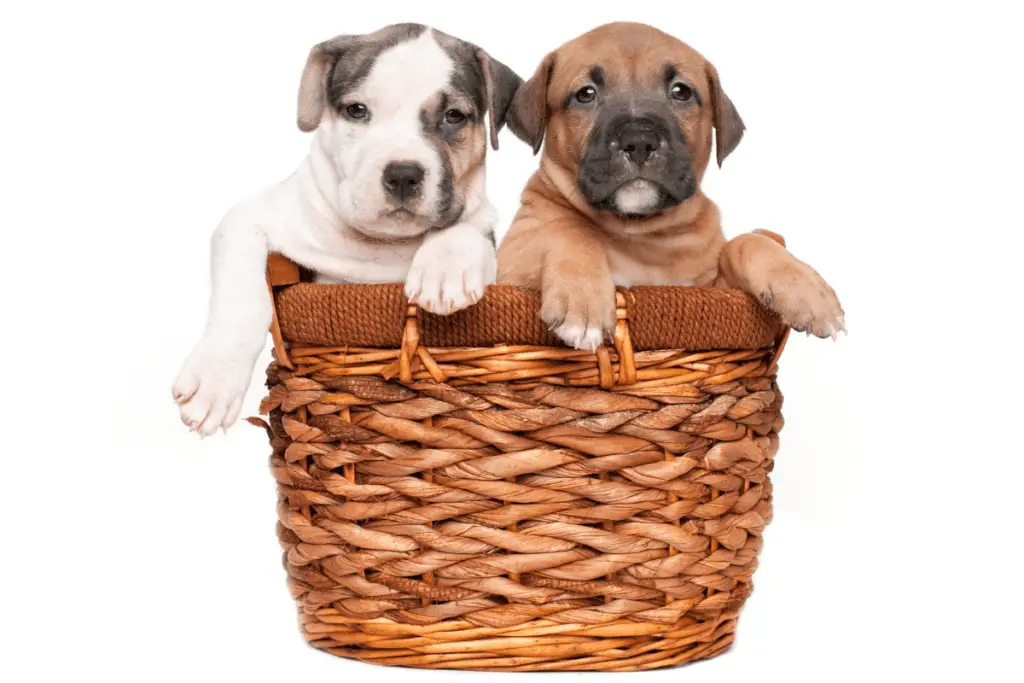
Puppy Nutritional Requirements Percentages
34-40% Protein Requirements
For many years, it was thought that high protein diets contribute to hip dysplasia and other forms of skeletal disease, but this is not the case.
Unfortunately most large breed puppy foods are still formulated with reduced protein levels and correspondingly higher carbohydrate content.
Since these “specialty foods” typically command higher prices for cheap, grain-based ingredients, the trend of promoting low protein diets for large breed puppies is likely to continue despite research indicating that these high carbohydrate formulas are not in the best interest of growing dogs.
High levels of quality proteins are required for healthy growth and the development of strong bones and a powerful immune system, so look for a food that provides protein in the 34-40% range.
Since puppies do not utilize proteins as efficiently as adult dogs, the quality of the protein in your puppy’s food is of particular importance.
High quality proteins such as eggs and muscle meats are over 90% digestible, while puppies can use only about half of the protein in low quality sources like most grains and by-product meals.
14-17% Fat Requirements
While high protein diets have proven not to cause skeletal problems, high energy diets are a different story.
Proteins and carbohydrates both provide 4 calories per gram, but fat weighs in at more than twice that, providing 9 calories per gram.
Consequently high fat diets are higher in calories, and high calorie diets are more likely to promote rapid growth. Since fast growth rates have been linked to skeletal abnormalities in large breed puppies, it’s advisable to choose a food that contains moderate levels of fat for your pit bull puppy.
Many large breed puppy formulas contain sharply reduced fat levels, and while fat content in the 10-12% range is unlikely to produce deficiencies, these amounts are less than optimal for a growing dog.
Instead, look for formulas providing 14-17% fat with an emphasis on quality animal fats such as salmon oil and naturally preserved chicken fat.
20-30%Carbohydrate Requirements
Dogs have no nutritional requirement for carbohydrates, and puppies are no exception.
Amylase, the enzyme needed to digest starches, is not present in dogs’ saliva, and pancreatic amylase levels are very low in puppies. That’s why carbohydrates should comprise no more than 25-30% of your puppy’s diet.
Unfortunately most large breed puppy formulas contain double that amount.
Feeding such a high carbohydrate food means your pit bull puppy won’t be able to assimilate a good chunk of the nutrients in his diet. It can also produce loose stools and diarrhea.
1.1-1.5% Calcium Level
Numerous studies have linked high calcium intake to skeletal abnormalities in large and giant breed puppies.
While calcium deficiencies and calcium/phosphorous imbalances are also prime culprits of bone problems, they are unlikely to occur when puppies are fed a quality commercial food.
Calcium excesses, on the other hand, are quite common, particularly in high protein, low carbohydrate formulas.
One study found that, when combined with high levels of vitamin D (vitamin D promotes calcium absorption), as little as 2.05% calcium was sufficient to produce significant skeletal changes.
A number of grain free, high protein kibbles contain in excess of 2% calcium, and most of these foods are designated as appropriate for all life stages.
Obviously such high amounts of calcium should be avoided when choosing a food for your pit bull puppy. It’s best to stick to a calcium level between 1.1% and 1.5%.
Avoid Overfeeding
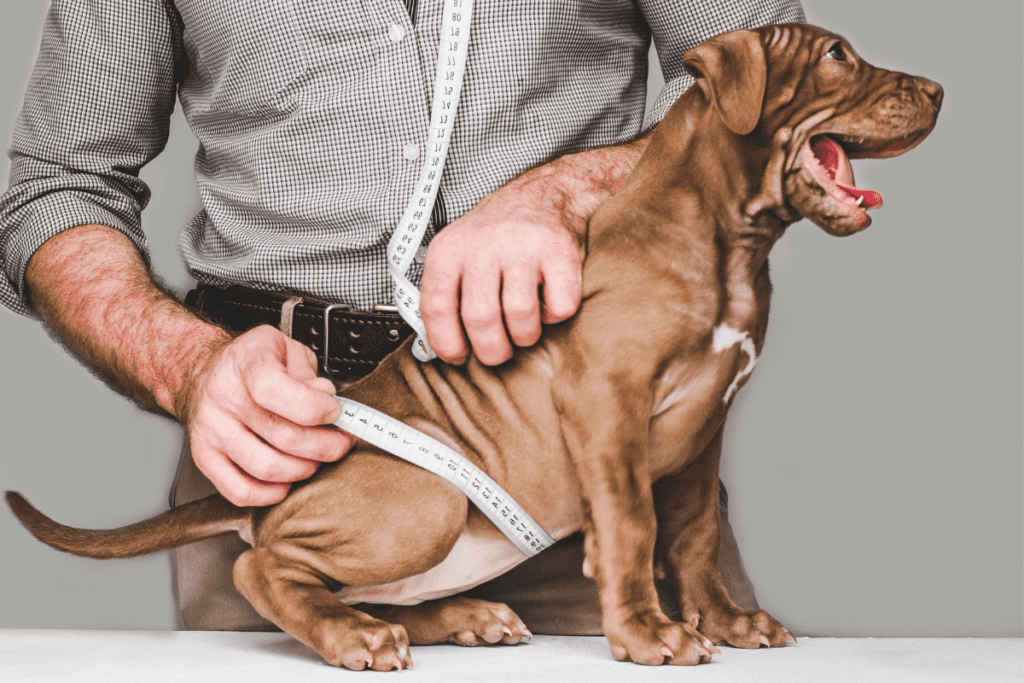
The perhaps most important factor of all is to feed for a slow, gradual growth rate. This means keeping your puppy lean.
Avoid overfeeding, and don’t leave food out all day. Until your puppy is 12 weeks old, you can feed four small meals a day.
Three to six month old puppies should be fed three times a day. After six months, switch to two daily feedings.
Pit Bull Puppy Feeding Schedule
As an average feeding schedule, puppies up to 12 weeks old should have four to six small meals every day. Each meal should contain between a quarter and a half cup of food. At six months, lower the number of daily feedings to two.
The quantity of food supplied to an adult dog is determined by his weight; nevertheless, growing pups are generally fed according to their age rather than their mass.
The majority of pit bulls wean at four weeks old. When they begin to wean, puppies will require more substantial meals.
As an easy rule to follow, do not allow your puppy to eat from a bowl all day. If you have trouble keeping track of your dog’s meals, make a feeding chart to help you stay organized.
What Nutrients Do Pit Bull Puppies Require?
Protein is essential for Pit Bulls since it provides them with needed nutrients. When you’re buying dog food, look for a concentration of at least 22% protein. Protein requirements are lower in older dogs than in puppies, however it is still important to their diet.
So, if you want to avoid your dog becoming obese, do not feed them a diet that is high in grains.
Even though pit bulls are not as tall as other breeds, they may benefit from high-quality puppy chow that is tailored for large dogs.
Should You Supplement A Pit Bull Puppy’s Diet?
You don’t need to supplement your pit bull puppy’s high-quality food if you’re feeding him high-quality food. High-quality puppy diets are already rich in nutrients, so adding extra supplements is pointless and may even be harmful.
Pit Bulls are prone to hip dysplasia and joint problems, so you might want to give your puppy a supplement for these issues once it no longer eats puppy food.
It is always recommended to speak with your veterinarian before giving your dog any sort of medication.
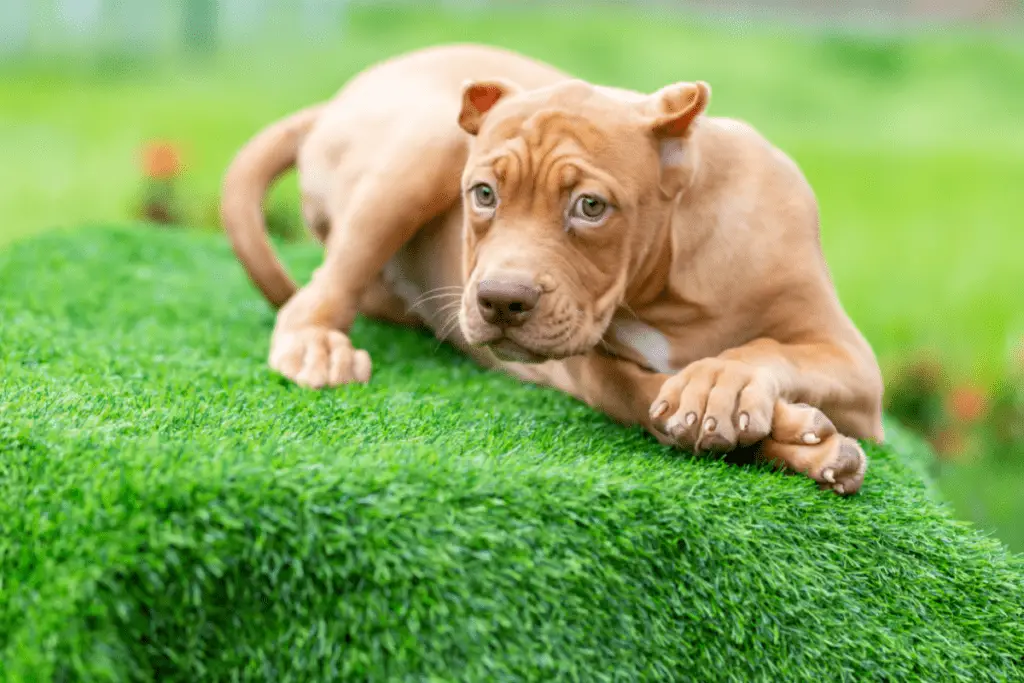
How Much Water Does A Pit Bull Puppy Need?
Pit Bull puppies need to drink more water than adult Pit Bulls, especially if they have lately stopped nursing. A half cup of water every two hours is required for a younger puppy.
Puppies may decrease the amount of water they consume as they get older, but it must be given throughout the day. When housetraining your puppy, you may want to restrict access to water during the night.
Your puppy needs about one ounce of water for each pound of body weight every day.
Pit Bull Puppy Diet Summary
To give your pit bull puppy the best chance of growing up strong and healthy, choose a food that provides:
- 34-40% protein (mostly muscle meats and other high quality sources)
- 14-17% fat (preferably high quality animal fats)
- 20-30% carbohydrate (less is fine)
- 1.1-1.5% calcium
And remember to monitor your puppy’s growth rate and keep her lean and trim.
Don’t worry if your puppy is smaller than other pit bulls in her puppy class. This is not a race to see who can grow up the fastest.
By making sure your puppy reaches her full adult size slowly and gradually without sudden growth spurts, you can drastically reduce the risk of skeletal disorders that can lead to a lifetime of problems.

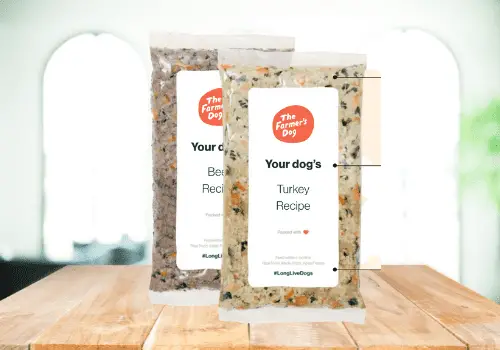
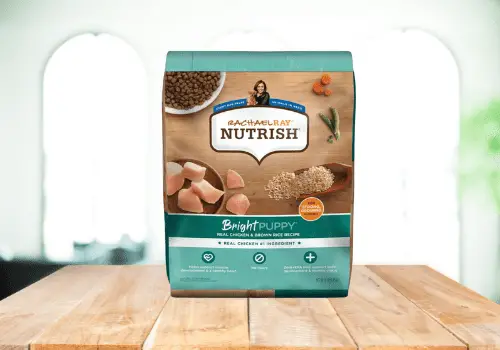
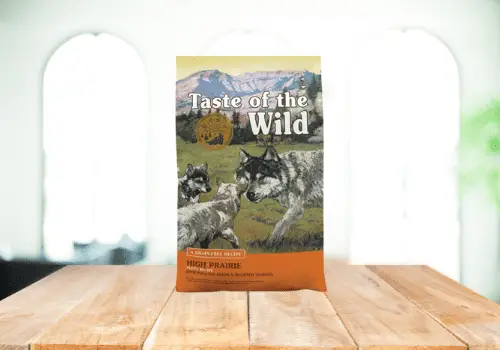
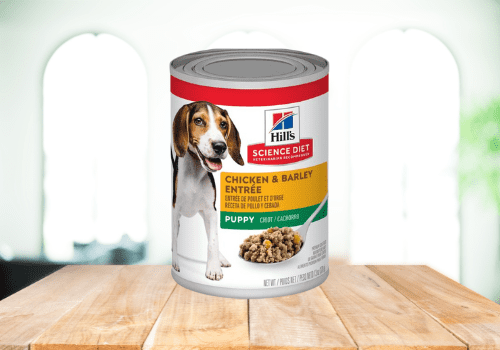
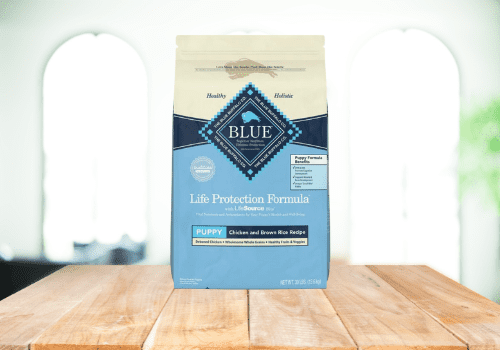
here is a good resource for
here is a good resource for dog food. http://pitbullfamily.topicboards.com/t42-dog-food-grading-chart
I look at it this way. When
I look at it this way. When is your dog the most active. When does it burn the most energy. Thats how you plan the feeding schedule. Lets say that a dog, lets say 15 pounds, is suppose to get 3 cups of kibble a day. I seriously doubt that a dog that size is gonna eat 3 cups all at once. More than likely the dog is gonna vomit the food back up because of it being to much food at once. So you would, (I hope, instinctively), give a cup in the morning, a cup in the afternoon, and a cup in the evening. I have a 3 month old Blue and he requires 3 cups of kibble a day. I substitute a cup of kibble with a raw chicken leg. But if you give your dog chicken legs make sure to take out the small bone that runs against the leg bone. It will for sure be a problem if they eat that wrong. So doing this he gets a good amount of protein, and vitamins from the bone. Also a good source of teeth cleaning with the bone to help you keep the pearly whites clean. It also works the muscles in the head to keep them in shape. Unlike the kiibble. If you feed your dog in the evening he more than likely will be thin. Because he has already burned everything from the feeding the night before. If you do just feed once a day it would probably be best to feed in the late morning. I know my dogs don’t get active till around 10-11 in the morning. So i feed around 7-8. Giving their bodies time to process the nutreints before they get active so they have nutreints on the ready to burn for play.
I have a 4 month old pit hes
I have a 4 month old pit hes about 25lbs. I have been feeding him 1.5 cups of chow twice a day is this ok?
Is wellness a good food to
Is wellness a good food to feed your pits?
It is better for an adult
It is better for an adult dogs body metabolism if s/he is fed twice a day
I feed Riley once a day, he’s
I feed Riley once a day, he’s healthy, whatever works best for you! 🙂
that dont make any sence….u
that dont make any sence….u should accustom your adult dog to only get fed once a day…………
That’s fine for smaller dogs.
That’s fine for smaller dogs. But for larger dogs, you probably want to schedule at least 2 regular feedings per day.